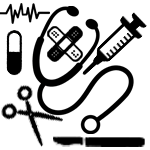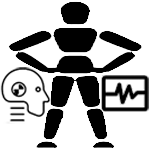Technology Integration Through Modality Mapping Initiative (TIMMI)
Definitions
Examples
Cognitivism is concerned with the complex cognitive processes of a learner, such as information processing and problem solving. Cognitivist learning theories describe the mind as akin to a computer, with terms like “working memory” and “long-term memory”
 Pattern Recognition
Pattern Recognition - Identifying anomalies
- Applying a diagnostic algorithm
 Attention Redirection and Multitasking
Attention Redirection and Multitasking - Collecting a history while conducting a physical exam
- Recovering from an interruption during medication administration
 Decision Making
Decision Making - Deciding to honor a patient’s wishes
- Choosing a course of action in treatment
 Knowledge Recall and Retention
Knowledge Recall and Retention - Listing steps of a procedure
- Describing anatomical features
Constructivism explains how individual learners create meaning from new knowledge and experiences. Constructivist learning theories facilitate the formation of new knowledge structures that are reconciled and integrated with previous understanding, primarily through active experiential learning in collaboration with other learners. Constructivism uses terms like “scaffolding”.
 Reflection on Action
Reflection on Action- Identifying strengths and weaknesses in performance
- Recognizing a system failure
 Clinical Reasoning
Clinical Reasoning - Formulating working and differential diagnoses
- Responding appropriately to clinical cues
 Knowledge Application
Knowledge Application- Practicing the SPIKES model of delivering bad news
- Administering the appropriate dosage of a medication
 Prioritization
Prioritization- Ranking steps
- Recognizing a patient that needs urgent or emergent care
 Adaptability
Adaptability- Reacting to a change in patient status
- Modifying the approach to care when new information is presented
Socio-constructivism (or social constructivism) asserts that learning occurs first at an interpersonal level before transitioning to a personal one. Socio-constructivist learning theories consider the socio-cultural context of both teaching and learning, with a particular focus on language and communication as mediating factors. Collaboration identifies collaboration as central to the formation of deep understanding for both an individual and their group.
 Leadership
Leadership- Identifying and challenging suboptimal practice
- Facilitating productive collaboration
 Communication Skills
Communication Skills- Breaking bad news
- Patient education
 Interpersonal Skills
Interpersonal Skills- Cultural humility
- Emotional intelligence
 Situational Awareness
Situational Awareness- Recognizing the importance of seemingly unimportant things
- Considering environmental factors
 Teamwork
Teamwork- Neonatal resuscitation protocol
- Rehabilitation of a chronically ill patient
 Conflict Resolution
Conflict Resolution- Deescalating volatile situations
- Productive disagreement
 Professional Identity Formation
Professional Identity Formation- Assuming the practicing healthcare role
- Modeling professional standards and ethics
Behaviorism describes how a relationship between a stimulus and a response is established, embedded, and sustained by a learner. Behaviorist learning theories focus on the reactions within and consequences of an observable performance; they seek to reinforce responses to increase the probability of retention and recall.
 Psychomotor Skills
Psychomotor Skills- Suturing
- Injection
 Procedural Skills
Procedural Skills - Changing a wound dressing
- Central line placement
 Technical Skills
Technical Skills- Canulation
- Intubation
 Immersive XR Modality A category that encompasses the hybrid combination of virtual reality environments and reality (e.g., real environment, standardized patient, normal manikin simulator). Often encompasses the definition of Augmented Reality (AR), but has more virtual features than typical AR. The blend of what is physically present to what is 100% computer-generated is expressed in this continuum: Reality – Augmented Reality – Mixed Reality – Virtual Reality (Hsieh and Lee, 2017).1
Immersive XR Modality A category that encompasses the hybrid combination of virtual reality environments and reality (e.g., real environment, standardized patient, normal manikin simulator). Often encompasses the definition of Augmented Reality (AR), but has more virtual features than typical AR. The blend of what is physically present to what is 100% computer-generated is expressed in this continuum: Reality – Augmented Reality – Mixed Reality – Virtual Reality (Hsieh and Lee, 2017).1 Full Body Manikin Modality A term often used to refer to the broad range of full-body manikins that have the ability to mimic, at a very high level, human body functions. Also known as a high-complexity simulator. Other types of simulators can also be considered high-fidelity, and that fidelity (realism) has other characteristics beyond a particular type of simulator.1
Full Body Manikin Modality A term often used to refer to the broad range of full-body manikins that have the ability to mimic, at a very high level, human body functions. Also known as a high-complexity simulator. Other types of simulators can also be considered high-fidelity, and that fidelity (realism) has other characteristics beyond a particular type of simulator.1 Standardized Patient Actor Modality A person who portrays a patient (simulated patient), family member, or health care provider in order to meet the objectives of the simulation; a simulated person may also be referred to as a standardized patient/family/health care provider if they have been formally trained to act as real patients in order to simulate a set of symptoms or problems used for health care education, evaluation, and research. Simulated persons often engage in assessment by providing feedback to the learner (Palaganas, et al., 2012).1
Standardized Patient Actor Modality A person who portrays a patient (simulated patient), family member, or health care provider in order to meet the objectives of the simulation; a simulated person may also be referred to as a standardized patient/family/health care provider if they have been formally trained to act as real patients in order to simulate a set of symptoms or problems used for health care education, evaluation, and research. Simulated persons often engage in assessment by providing feedback to the learner (Palaganas, et al., 2012).1 Task trainer/Partial Modality A device designed to train in just the key elements of the procedure or skill being learned, such as lumbar puncture, chest tube insertion, central line insertion or part of a total system, for example, ECG simulator (Center for Immersive and Simulation Based Learning [CISL] & Levine et al). A model that represents a part or region of the human body such as an arm, or an abdomen. Such devices may use mechanical or electronic interfaces to teach and give feedback on manual skills such as IV insertion, ultrasound scanning, suturing, etc. Generally used to support procedural skills training; however they can be used in conjunction with other learning technologies to create integrated clinical situations (Australian Society for Simulation in Healthcare).1
Task trainer/Partial Modality A device designed to train in just the key elements of the procedure or skill being learned, such as lumbar puncture, chest tube insertion, central line insertion or part of a total system, for example, ECG simulator (Center for Immersive and Simulation Based Learning [CISL] & Levine et al). A model that represents a part or region of the human body such as an arm, or an abdomen. Such devices may use mechanical or electronic interfaces to teach and give feedback on manual skills such as IV insertion, ultrasound scanning, suturing, etc. Generally used to support procedural skills training; however they can be used in conjunction with other learning technologies to create integrated clinical situations (Australian Society for Simulation in Healthcare).1 Screen Based Application Modality A simulation presented on a computer screen using graphical images and text, similar to popular gaming format, where the operator interacts with the interface using keyboard, mouse, joystick, or other input device. The programs can provide feedback to, and track actions of learners for assessment, eliminating the need for an instructor (Ventre & Schwid, in Levine Chapter 14). A computer-generated video game simulator that can create scenarios that require real-time decision-making (Bonnetain, Biese, et al., 2009).1
Screen Based Application Modality A simulation presented on a computer screen using graphical images and text, similar to popular gaming format, where the operator interacts with the interface using keyboard, mouse, joystick, or other input device. The programs can provide feedback to, and track actions of learners for assessment, eliminating the need for an instructor (Ventre & Schwid, in Levine Chapter 14). A computer-generated video game simulator that can create scenarios that require real-time decision-making (Bonnetain, Biese, et al., 2009).1 Mobile Application Modality A mobile application, most commonly referred to as an app, is a type of application software designed to run on a mobile device, such as a smartphone or tablet computer. Apps are generally small, individual software units with limited function.2
Mobile Application Modality A mobile application, most commonly referred to as an app, is a type of application software designed to run on a mobile device, such as a smartphone or tablet computer. Apps are generally small, individual software units with limited function.2 Serious Games Modality A mental contest played with a computer in accordance with specific rules, which uses entertainment to further training, education, health, public policy, and strategic communication objectives (Zyda, 2005). A game designed for a primary purpose other than pure entertainment. Serious games have an explicit and carefully thought out educational purpose, and are not intended to be played primarily for amusement (Michael and Chen, 2006). Serious games are simulations of real-world events, or processes designed for the purpose of solving a problem. The “serious” adjective is generally appended to refer to products used by industries like defense, education, scientific exploration, healthcare, emergency management, city planning, engineering, religion, and politics.1
Serious Games Modality A mental contest played with a computer in accordance with specific rules, which uses entertainment to further training, education, health, public policy, and strategic communication objectives (Zyda, 2005). A game designed for a primary purpose other than pure entertainment. Serious games have an explicit and carefully thought out educational purpose, and are not intended to be played primarily for amusement (Michael and Chen, 2006). Serious games are simulations of real-world events, or processes designed for the purpose of solving a problem. The “serious” adjective is generally appended to refer to products used by industries like defense, education, scientific exploration, healthcare, emergency management, city planning, engineering, religion, and politics.1Modality Reverse Mapping
Examples
 Pattern Recognition
Pattern Recognition - Identifying anomalies
- Applying a diagnostic algorithm
 Attention Redirection and Multitasking
Attention Redirection and Multitasking - Collecting a history while conducting a physical exam
- Recovering from an interruption during medication administration
 Decision Making
Decision Making - Deciding to honor a patient’s wishes
- Choosing a course of action in treatment
 Knowledge Recall and Retention
Knowledge Recall and Retention - Listing steps of a procedure
- Describing anatomical features
 Reflection on Action
Reflection on Action- Identifying strengths and weaknesses in performance
- Recognizing a system failure
 Clinical Reasoning
Clinical Reasoning - Formulating working and differential diagnoses
- Responding appropriately to clinical cues
 Knowledge Application
Knowledge Application- Practicing the SPIKES model of delivering bad news
- Administering the appropriate dosage of a medication
 Prioritization
Prioritization- Ranking steps
- Recognizing a patient that needs urgent or emergent care
 Adaptability
Adaptability- Reacting to a change in patient status
- Modifying the approach to care when new information is presented
 Leadership
Leadership- Identifying and challenging suboptimal practice
- Facilitating productive collaboration
 Communication Skills
Communication Skills- Breaking bad news
- Patient education
 Interpersonal Skills
Interpersonal Skills- Cultural humility
- Emotional intelligence
 Situational Awareness
Situational Awareness- Recognizing the importance of seemingly unimportant things
- Considering environmental factors
 Teamwork
Teamwork- Neonatal resuscitation protocol
- Rehabilitation of a chronically ill patient
 Conflict Resolution
Conflict Resolution- Deescalating volatile situations
- Productive disagreement
 Professional Identity Formation
Professional Identity Formation- Assuming the practicing healthcare role
- Modeling professional standards and ethics
 Psychomotor Skills
Psychomotor Skills- Suturing
- Injection
 Procedural Skills
Procedural Skills - Changing a wound dressing
- Central line placement
 Technical Skills
Technical Skills- Canulation
- Intubation
 Immersive XR Modality
Immersive XR Modality- Behaviorism
- Cognitivism
- Constructivism
- Socio-Constructivism
 Full Body Manikin Modality
Full Body Manikin Modality- Behaviorism
- Cognitivism
- Constructivism
- Socio-Constructivism
 Standardized Patient Actors Modality
Standardized Patient Actors Modality- Cognitivism
- Constructivism
- Socio-Constructivism
 Task Trainer/Partial Modality
Task Trainer/Partial Modality- Behaviorism
- Cognitivism
 Screen Based Application Modality
Screen Based Application Modality- Cognitivism
- Constructivism
 Mobile Application Modality
Mobile Application Modality- Cognitivism
- Constructivism
 Serious Games Modality
Serious Games Modality- Constructivism
- Socio-Constructivism
The TIMMI is designed to aid in the design of effective simulation activities; it is not intended to be prescriptive or inflexible.
